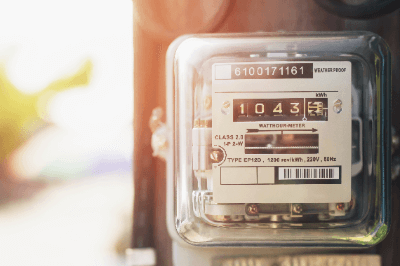What Is a Watt-hour Meter?

A Watt-hour meter is an electrical device used to measure the amount of electricity used by a consumer. By measuring the amount of electricity used by factories and residences, Watt-hour meters automatically calculate electricity rates for customers. Watt-hour meters have built-in ammeters and voltmeters, whose values are used to calculate the amount of electricity used. Watt-hour meters have been conventionally equipped with an aluminum disk that rotates to measure the amount of electricity used.
Uses of Watt-hour Meters
Watt-hour meters are used to measure the amount of electricity consumed by customers. Watt-hour meters are generally found on the exterior walls of homes. By looking at the value displayed on a Watt-hour meter, the amount of electricity used by a household can be calculated. The electric company checks the value displayed and calculates the monthly charge.
Meters are installed not only in homes, but also in factories, commercial facilities, and other buildings that use electricity. All buildings that use electricity are required to have the amount of electricity used checked and are obliged to pay electricity charges.
Principle of Watt-hour Meters
Electricity consumption (Wh) is calculated by continuously measuring the electric power (P) used per second, dividing it into hourly units, and adding these values together to calculate the amount of electricity used for a given period of time.
There are two types of Watt-hour meters in common use: inductive and electronic.
Inductive Watt-hour meters consist of a current coil, a voltage coil, an aluminum disk, and a measurement device. The magnetic force of the current coil and voltage coil connected to the load generates electromagnetic induction, which rotates the aluminum disk for measurement.
The electronic Watt-hour meter does not use the mechanism of a rotating disk. In the electronic type, a built-in electronic circuit measures the current and voltage of the load and calculates the amount of electric energy. The electronic type has a less mechanical structure and is less prone to breakdowns. It has the advantage of operating for relatively long periods of time without problems.
Recently, smart meters have come into use, allowing for more detailed measurement of electricity consumption as they provide the ability to remotely check Watt-hour meter readings.
Smart Meters for Watt-hour Meters
Analog induction-type Watt-hour meters have traditionally been the norm. These meters have a structure in which a disk rotates when electricity is used, allowing the amount of electricity to be measured by the number of revolutions. In recent years, digital Watt-hour meters called smart meters are beginning to replace analog meters. Smart meters can send data to remote locations, allowing users to check the amount of electricity they are using even in remote areas. These meters also provide “electricity visualization,” by digitally displaying the amount of electricity used, and can be expected to increase users’ awareness of their energy consumption and the need for energy conservation. In terms of electricity contracting, because the breaker is built into the smart meter, there is no need to replace it, as in the past. In addition, the electric company will be able to easily monitor the status of electricity usage, which may lead to cost reductions and even lower electricity rates by reducing wasteful power generation. Conversely, a demerit of smart meters is the possibility of the invasion of consumers’ privacy. Lifestyle patterns, family composition, and other information can be inferred from electricity usage data generated by smart meters.